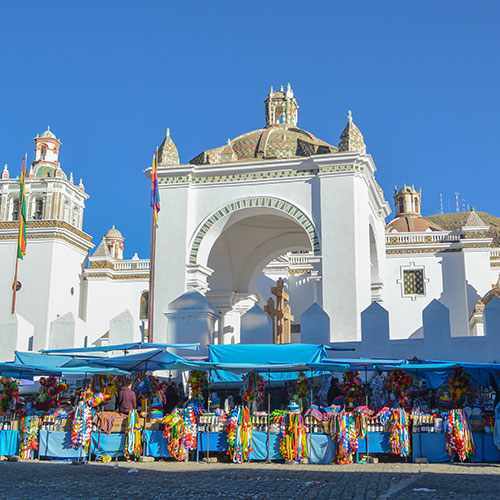Copacabana lies only 5 miles north of the border with Peru, and about 96 miles from La Paz. The central Andean region in which one finds Copacabana is dominated by the world's highest navigable lake, massive Lake Titicaca, 44% of which pertains to Bolivia. Copacabana Peninsula occupies both the Peruvian and Bolivian side of the border, and along its north side is Yampupata Peninsula, which has only small Yampupata Strait between it and Isla del Sol, or Sun Island, Copacabana's principal attraction.
Although there are many islands on Bolivia's side of Lake Titicaca, Isla del Sol is the largest among them. Just slightly north of Copacabana Peninsula, it's a long island with two bays, which boasts numerous agricultural terraces, more than 80 ruins from both the Kingdom of Tiahuanaco and Inca times, and an Inca legend which named it the sacred site of origin for their culture and the birthplace of the supreme deity, Inti, the sun god. Koati, or the Isla de la Luna, is another popular stop due to housing the remains of an Incan acllahuasi.
The area now known as Copacabana was inhabited by various ancient cultures such as the Chirípa, although its first large civilization arose around 200AD- the Aymara Kingdom of Tiahuanaco, which constructed important shrines upon the islands of Lake Titicaca. After the Inca conquest of this region in the 15th century, they adopted many of these shrines. During the time of the Inca Empire, Copacabana served as one of the Bolivian outposts of Inca occupation. It was important as an access point to the ancient shrine and oracle of Titicaca Island, which was sacred to the Aymara even before the rise of the Incas.
The Dominicans adopted Copacabana as a mission center in the 1530s, although the mission was transferred to the Augustinians in 1589. A history of the Catholic influence in this area, syncretically combined with pre-Columbian beliefs, is attested to by the stations of the cross along Cerro Calvario, Calvary Hill, and the Moorish-style 17th century Copacabana Cathedral, one of the oldest churches in Bolivia. The latter of which houses the famous Dark Virgin, or Virgen de la Candelaria. The original statue was carved from cactus in the 1580s by Francisco Tito Yupanqui, nephew of the former Inca emperor Huayna Capac. It soon acquired a reputation for granting miracles, attracting devout believers from throughout Bolivia and southern Peru, making Copacabana Bolivia's premier pilgrimage site. The chapel has remained a destination in itself for mainly indigenous believers, despite years of neglect and the desecration and plundering of most of its ornaments and riches during the Wars of Independence and following political disturbances.
The current partition of Lake Titicaca between Peru and Bolivia was officially set after Peru and Bolivia gained their independence from Spain in the 1820s.

1 dias /0 noches